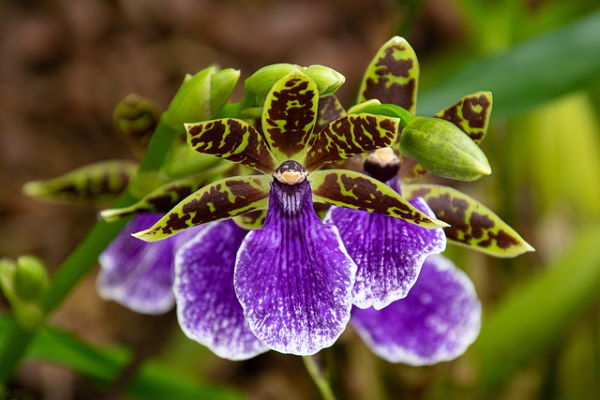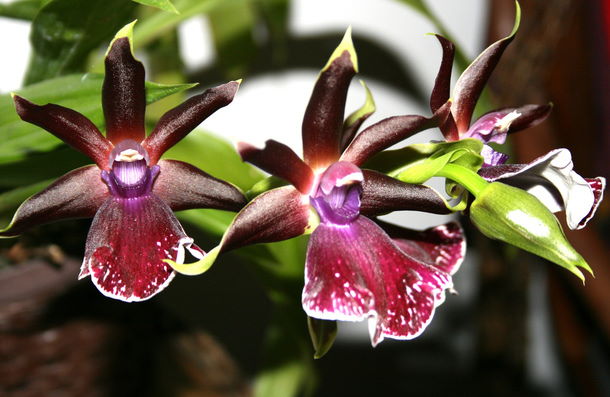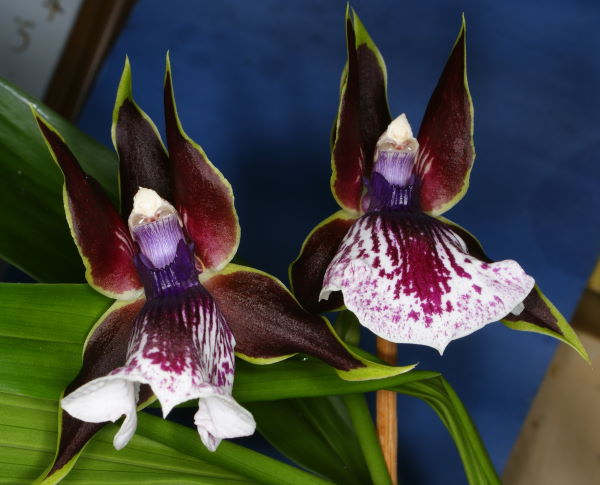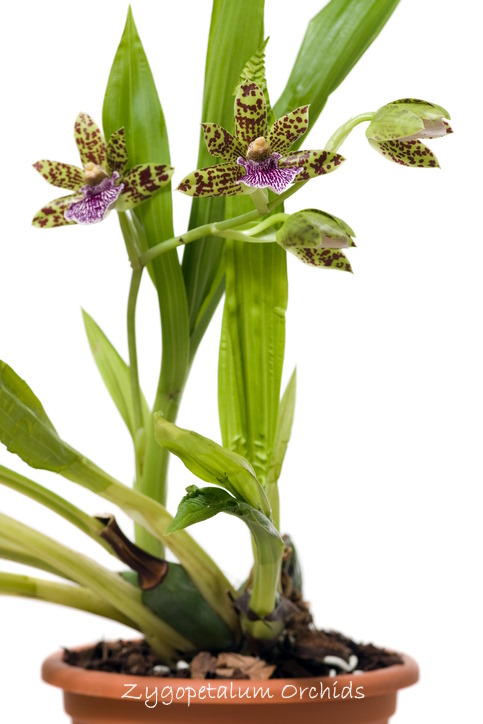Zygopetalum Orchid Care
Zygopetalum orchid is treasured for its bold, look-at-me colors and daring patterns. But that's only part of its appeal. Zygo's sweet fragrance and easy culture make it a must-have orchid.
In this guide, you'll discover how to grow these captivating orchids indoors. Find out what type of light and temperature makes them bloom, plus how much to water and when to repot.
 Zygopetalum mackayi is among the most popular varieties.
Zygopetalum mackayi is among the most popular varieties.Get to Know Your Zygos
Zygopetalum spp. are terrestrial orchids native to South America and Central America.
Zygopetalums are robust, growing fans of long, lily-like leaves from large pseudobulbs. Deeply ribbed, the leaves are light green and reach nearly 2 ft (60 cm) tall. You can expect a new flush of foliage every year.
Most bloom in winter or early spring, filling a room with delightful fragrance. Tall, upright stems hold the flower clusters at the top. Each bloom is spectacular. The petals and sepals flaunt stunning combinations of burgundy, green or violet and a large lip radiates pink or purple lines and spots.
How big do Zygopetalum orchids get? They vary by species, but mature plants will grow up to 3 ft (90 cm) tall.
 Zygos bear a bountiful crop of blooms on upright stems.
Zygos bear a bountiful crop of blooms on upright stems.Growing Zygopetalum Orchid: Care, Solutions and Answers
No blooms? If your healthy Zygopetalum orchid fails to flower, the cause is likely light and/or temperature. Orchids won't bloom without plenty of bright, indirect light. (See "Light" tips below.) Cooler nighttime temperatures help, too. (See "Temperature" tips below.) Is it a new plant? Orchids need to be a few years old before they'll bloom. Be patient, they're worth it.
To repot...or not. Young plants can stay in a smallish pot (6- to 8-inch) for the first couple years. Use a pot with a drainage hole to prevent soggy potting medium, which can lead to root rot. Although they get big, Zygopetalums grow upright and likely won't need repotted until you want to divide the plant. Never repot a plant in bloom -- wait until after flowering is over and before new growth begins.
Something bugging your orchid? Aphids are common houseplant pests. They're typically found on new growth, along stems and new buds. Their sap-sucking activities distort flower stems and may cause flower buds to fall off. Check your plant often for these destructive pests, including checking for honeydew, a sticky substance excreted by aphids. If left untreated, aphids can multiply into a large infestation within days, then move on to your other houseplants.
Mealybugs are easy to find, covered with white, woolly coatings. You'll find them at the axils of leaves or flower spikes. Living in colonies, mealybugs also feed on sap, and like aphids, excrete sticky honeydew that may grow sooty mold. Treat any infestation immediately. Try to prevent them by gently wiping leaves with a damp cloth.
Dark spots on leaves. Water drops left on foliage for any length of time may cause black spots, leading to fungus. Cut off affected leaves to prevent the spread of fungus and/or spray affected area with an anti-fungal spray. Hot, direct sunlight may cause brown scorch marks -- they're not a problem as much as unsightly. Cut off badly scorched leaves, if you want.
 Zygo blooms are small, but captivating in bold colors and patterns.
Zygo blooms are small, but captivating in bold colors and patterns.Buying Tips
Zygopetalums are among the few terrestrial orchids that grow well indoors, and include about 15 species.
Although Zygopetalum orchids are regulars at orchid shows, you won't find them at garden centers. Your best bet is online nurseries that specialize in orchids. You'll likely find them for sale in the winter and early spring, when most of the species and hybrids are in bud or bloom.
Zygopetalum mackayi (shown at top) is one of the easiest-to-please species. Buy a mature plant or you'll have a long wait for the flowers.
 Photo credit istockphoto
Photo credit istockphotoZygopetalum Orchid Care Tips
Light: Bright light is the key to getting Zygos to bloom. Put your orchid where it'll get plenty of light, but out of direct sun. If you don't have a spot near a window, indoor grow lights work beautifully. Use 1 warm white tube and 1 cool white tube under a reflector. Place orchids about 8 inches (20 cm) beneath the light for 14-16 hours a day. It's also important to give them darkness at night. Orchids need a rest, too.
Water: Water carefully to avoid getting the pseudobulbs and leaves wet. Aim to keep the soil lightly moist during the growing season, slightly drier in the winter. Zygopetalums have water-storing pseudobulbs, making them more tolerant of dry medium than wet. Remember, always use room-temperature water for watering your houseplants; cold water is a shock to them.
Humidity: Zygos love humidity, preferably above 50% relative humidity. Indoor air can become extremely dry in winter. Use a humidity gauge near your plant, rather than guess. Don't mist Zygos because water drops will leave marks on the leaves if they are kept wet. The most efficient way I've found for increasing moisture around tropical houseplants is to use a humidity tray or cool-mist room humidifier. Grouping plants also helps to maintain the moisture in the air around them.
Temperature: Give your Zygopetalum orchid slightly cooler nighttime temperatures (60-65°F/16-18°C) and warm (70-75°F/21-24°C) days to get the most blooms.
Soil: Medium-grade fir bark
Fertilizer: Feed every 2 weeks while plant is actively growing with an orchid fertilizer. Add fertilizer to the water at every second or third watering.
Propagation: Divide clumps of pseudobulbs with a clean, sharp knife. Each division should have 2-4 pseudobulbs attached with roots. The best time to divide is after flowering is over, probably in spring.


